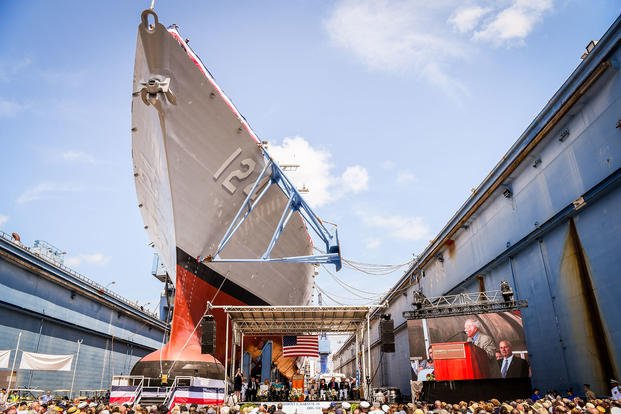Everything seemed to be going wrong for Company H on Dec. 18, 1965.
The 2nd Battalion, 9th Marines were on a search and destroy mission in Vietnam, hunting for massed Viet Cong forces near the village of Ky Phu. As the battalion moved off a mountain to head back to the village, the North Vietnamese suddenly attacked. Company H found itself cut off from the rest of the battalion, surrounded by open ground. Some Marines were wounded, the company commander and radio operator were killed, and the enemy fire was accurate and devastating.
With their attackers closing in, the Marines looked to Lt. Harvey C. Barnum, an artillery forward observer who had only been in Vietnam for two weeks, to lead them out. For what Barnum did in those next critical hours, the U.S. Navy presented him with the Medal of Honor; the service also just christened its newest Arleigh Burke-class guided missile destroyer in his honor, the first warship to bear his name.
In a ceremony at General Dynamics Bath Iron Works in Bath, Maine, on July 29, 2023, Barnum delivered remarks to the gathered crowd, along with Navy Secretary Carlos Del Toro, and a host of other officials. Barnum's wife, Ms. Martha Hill, christened the USS Harvey C. Barnum (DDG-124) by breaking the traditional bottle of sparkling wine across the ship's bow.

Barnum was born in Cheshire, Connecticut, on July 21, 1940, and graduated from high school in 1958. Inspired by a Marine recruiter who visited his school when he was 18, he went to Saint Anselm College in New Hampshire and joined the ROTC. By 1962, he was leading Marines as an officer. Stationed at Pearl Harbor in 1965, he volunteered for a temporary assignment in Vietnam. He was fighting the Viet Cong in less than two weeks.
Then-1st Lt. Barnum was the artillery forward observer for Company H when it was flown to a mountaintop near Ky Phu. They were replacing wounded companies fighting in Operation Harvest Moon, which sought to destroy the Viet Cong in the area. They weren't on the ground long before they were pinned down by enemy fire and cut off from the battalion.
Barnum ran into the open area around his position to retrieve the company commander, Capt. Paul Gormley, who died in his arms. Barnum ran out again to grab the radio off the slain radio operator. He'd called in artillery fire, but the shrapnel was dangerously close to his own men. He reorganized his Marines and did what Marines do best: He attacked.
A nearby enemy trench was laying down heavy fire on their position, so it became Barnum's first target. After neutralizing the closest enemy, the Marines were still cut off from their battalion. Barnum ran across the open ground to get to a place where he could use the radio. Fixed-wing aircraft were out; the weather was too bad. He managed to get two helicopters to help.
He repeatedly exposed himself to enemy fire so he could physically point out the targets to the gunships. When he finally raised the battalion commander, he was told the 2nd Battalion couldn't reach him, and he would have to hold out for the night or fight his way home.
With the casualties he had, staying put was not an option. He ordered his Marines to clear a landing zone so the helicopters could evacuate the wounded, destroying all their inoperable or useless gear to lighten their loads.
Barnum's Marines booked it across 500 meters of open rice paddy to make it to the relative safety of the village. Over the next 45 minutes, the Marines moved squad by squad across the difficult terrain under enemy fire. All his Marines made it and were evacuated from the village.
A few days later, Barnum was informed that he had been recommended for the Medal of Honor for his actions at Ky Phu. He hadn't been in Vietnam for even a month at that time. The medal was presented to him on Feb. 27, 1967, in Washington, D.C.

In October 1968, Capt. Harvey Barnum deployed to Vietnam for a full tour, commanding the same artillery he'd led out of a North Vietnamese turkey shoot nearly three years prior before retiring from the Marine Corps in 1989. He learned he would be the namesake of a guided missile destroyer in 2016.
"I've worn this Medal in Honor of those great Marines and corpsmen who fought with me on the battlefield that day who didn't walk off, or walked off seriously wounded," he said in a Veterans History Project interview in 2003. "There were no superstars, but I happened to be the quarterback calling the plays."
-- Blake Stilwell can be reached at blake.stilwell@military.com. He can also be found on Facebook, Twitter, or on LinkedIn.
Want to Learn More About Military Life?
Whether you're thinking of joining the military, looking for post-military careers or keeping up with military life and benefits, Military.com has you covered. Subscribe to Military.com to have military news, updates and resources delivered directly to your inbox.
















